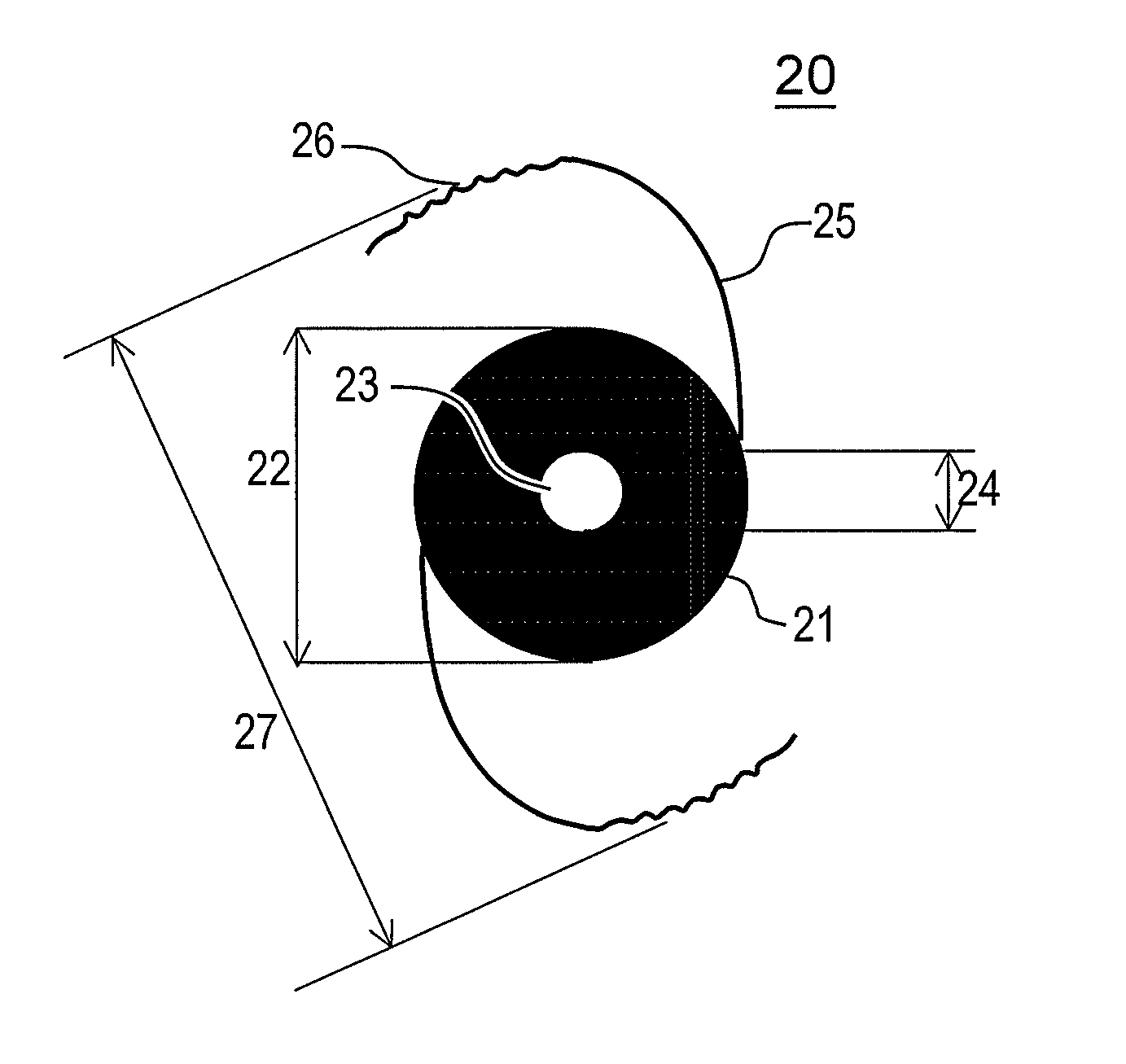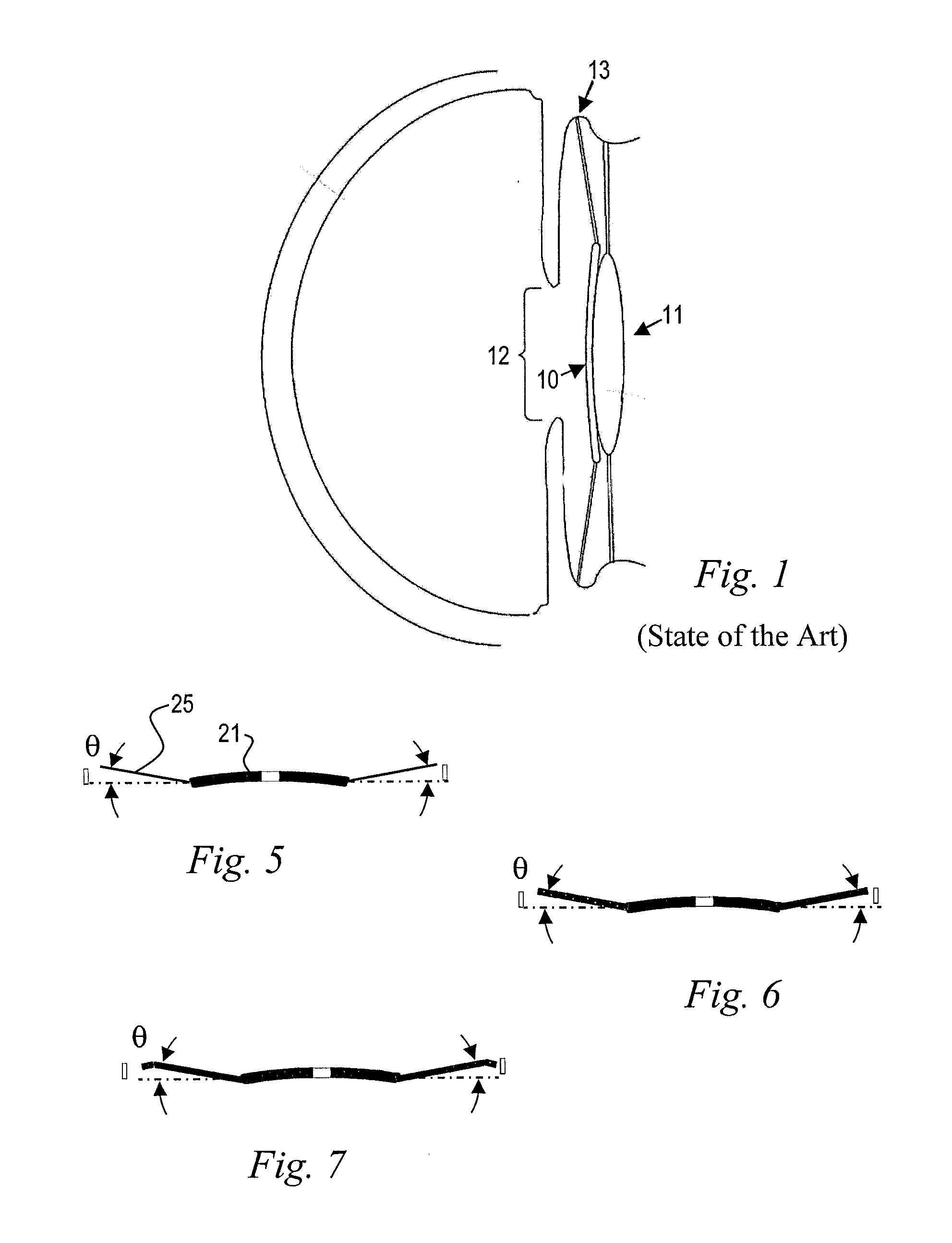Small aperture (pinhole) intraocular implant to increase depth of focus
a small aperture, intraocular implant technology, applied in the field of ophthalmology, can solve the problems of reducing contrast sensitivity and optical quality, affecting the effect of contrast, and reducing the effect of aberration, so as to promote an improvement in visual acuity, improve the depth of focus, and minimize the impact of aberration
- Summary
- Abstract
- Description
- Claims
- Application Information
AI Technical Summary
Benefits of technology
Problems solved by technology
Method used
Image
Examples
first embodiment
[0053]An embodiment of an implant according to the invention is described below in detail through exemplary achievements. Details are illustrated in FIGS. 2 and 5, which represent the invention.
[0054]Anintraocular implant comprises a body 20 shaped like a concave-convex diaphragm 21, made of rigid or flexible material, preferably flexible, the material or a coating or coloring layer is opaque to visible light, preferably black colored material or a black coating 22 with a diameter of between 4 mm and 7 mm, preferably between 5.5 mm and 6.5 mm.
[0055]In its central region a passage means 23 for visible light rays with a diameter 24 of between 1 mm and 2.5 mm, preferably between 1.4 mm and 2.0 mm is arranged, which allows a passage of light rays which, due to the pinhole effect, are sharply focused on the retina, inversely proportional to the diameter of the passage. The thickness of said diaphragm is between 100 μm and 900 μm, preferably between 200 μm and 400 μm.
[0056]Said pinhole ef...
second embodiment
[0069]Considering an implant configured illustrated in FIGS. 3 and 6, the most suitable materials for the whole-body handles 25′ would hydrophilic acrylic, hydrophobic acrylic, silicone and / or PMMA, preferably hydrophilic acrylic.
third embodiment
[0070]Further, an implant configured illustrated in FIGS. 4 and 7, suitable materials for the platform 30 would be silicone, acrylic hydrophobic and hydrophilic acrylic, preferably silicone.
[0071]In FIG. 8 an embodiment of an implant with a circular diaphragm 21 with hole 23 and four handles 25 is depicted. The implant of FIG. 8 is a modification of the embodiment of FIG. 3. The handles 25 can also comprise an undulated or zigzag distal end part 26 for improving fastening characteristics and flexibility. Another embodiment can also comprise three or five handles 23.
[0072]In FIGS. 9 and 10 further embodiments of an implant according to the invention are displayed. The implant comprises a diaphragm 21 being opaque to visible light and transparent to IR-light with a circular hole 23 in its center and two, three, four or even more loops 31. The loops 31 are formed in a bended curvature and both ends of each loop 31 is attached to diaphragm 21. Thus a lightweight and securely fastening ...
PUM
 Login to View More
Login to View More Abstract
Description
Claims
Application Information
 Login to View More
Login to View More - R&D
- Intellectual Property
- Life Sciences
- Materials
- Tech Scout
- Unparalleled Data Quality
- Higher Quality Content
- 60% Fewer Hallucinations
Browse by: Latest US Patents, China's latest patents, Technical Efficacy Thesaurus, Application Domain, Technology Topic, Popular Technical Reports.
© 2025 PatSnap. All rights reserved.Legal|Privacy policy|Modern Slavery Act Transparency Statement|Sitemap|About US| Contact US: help@patsnap.com



